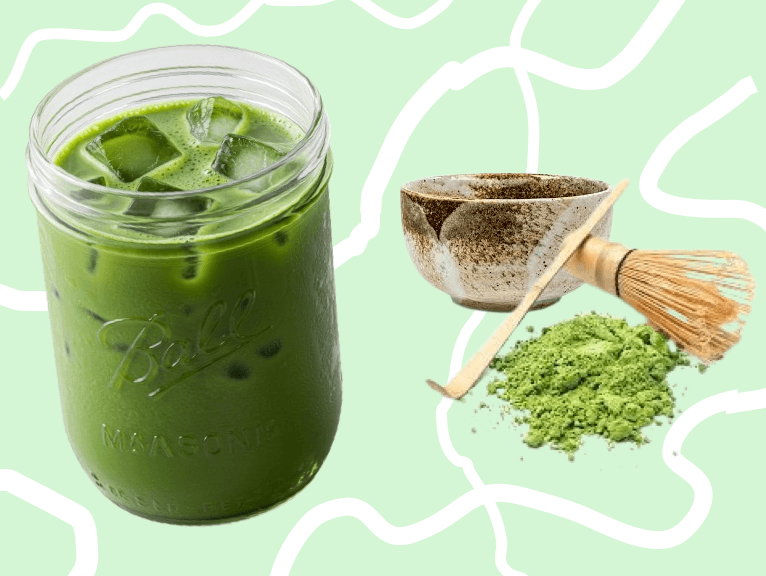
I Learned How to Make a Matcha Latte
Published: Mar 13, 2025
Matcha is a powder made from ground green tea leaves. It has a beautiful bright green color and a grassy umami (savory) flavor.
Matcha comes in two main grades: ceremonial and culinary. Ceremonial grade, made from the first tea harvest and with the stems removed, is considered higher quality and has a vibrant bright green color. Culinary grade, made from later harvests subjected to more sunlight, tends to be duller and more yellow or brown in color and tastes more bitter and stale.
The main steps to creating a matcha tea are to sift your powder into your cup or bowl to prevent clumps, to add water at the right temperature, and to whisk your matcha. Whisking matcha, traditionally using a bamboo whisk, aerates and breaks up the powder, preventing clumps and creating a smooth, frothy texture, unlike stirring which would result in a gritty drink. Whisking creates a light and airy texture. Water temperature also makes a big difference. Water that is too hot can "scorch" the matcha powder, leading to a bitter and unpleasant taste.
I like to enjoy matcha as a latte, balancing the bitter and grassy flavor of the tea with the sweetness of some milk and honey. You could get one at a trendy cafe for lots of money, but I prefer to make them at home for way cheaper. I also like to be in control of the strength of the tea and the amount of sweetness.
How to Make a Matcha Latte
Tools
- something to boil water (I use an electric kettle that boils water in no time)
- a mesh sifter (to remove lumps)
- a whisk (I use an electric metal whisk, but you could use the traditional bamboo whisk)
Ingredients
- Matcha powder (preferably using a quality matcha powder, ceremonial or “ceremonial blend” which is a mix of ceremonial and culinary grade)
- Hot Water (temperature will affect the taste - 140 F to 175 F or 60 C to 80 C is recommended)
- Your choice of Milk. Heat it up gently in a saucepan or using a milk frother for a frothier latte.
- Optional: honey (or your choice of sweetener)
Instructions
- boil some water
- sift anywhere between 1/2 tsp. to 1 1/2 tsp. of matcha powder into a mug depending on the strength you want. If you are making an iced latte I would recommend more matcha powder.
- let your water cool down a bit and then pour the hot water over your sifted matcha powder (temperature will affect the taste - 140 F to 175 F or 60 C to 80 C is recommended)
- Whisk until dissolved and frothy.
- Add hot milk and honey (or your choice of sweetener) and whisk to combine until frothy
- Optional: pour over ice for an iced latte
Green tea leaves contains caffeine, so matcha has a stimulant effect. It also contains an amino acid called L-theanine that apparently promotes relaxation. When combined with caffeine, L-theanine is said to help to create a state of "calm alertness." This means you can experience the increased focus and energy from caffeine, but with reduced jitters and anxiety. This can make it an appealing alternative to coffee for those looking for a caffeine fix that is a bit more subtle and smooth.
Green tea has been consumed in China and Japan for centuries, and is said to have been used in Zen Buddhist monasteries for meditation due to its calming and focusing effects. The tea is said to have helped monks maintain concentration during extended meditation sessions. The ritual of preparing and drinking tea also became a form of mindful practice.
The Japanese tea ceremony, heavily influenced by Zen Buddhism, evolved as a ritualized practice where its preparation and consumption are meticulously performed:
I don’t think I’ll be donning a kimono and kneeling on tatami mats performing the intricate dance of the tea ceremony anytime soon, but I am interested in slowing down more in my day-to-day life with something like “tea meditations”.
A "tea meditation" is a mindfulness practice that uses the preparation and consumption of tea as a focus for meditation. It's about bringing awareness to the present moment through the sensory experience of making and drinking tea. The goal is to slow down and pay attention to each step of the process.
The mindful approach of a tea meditation can be applied to many other areas of life too. I’ve recently been trying to eat my meals without screen stimulation around, and I’m finding it extremely refreshing. It is surprisingly nice to just let my thoughts wander as I stare off into the distance in silence. I have a high screen time and am chronically overstimulated and distracted, so it is a nice change of pace to let my mind sort itself out a bit and to let myself breathe.
Matcha lattes are a great alternative to coffee to get a more mellow caffeine fix in the morning. They have a delicate grassy flavor that goes well with frothy milk and honey. They have a beautiful bright green color that is pleasing to the eye. The history and aesthetics of tea drinking cultures have made me intrigued by the idea of slowing down and approaching my daily tasks with more mindfulness. Learning about matcha has taught me that sometimes it is worth stopping and paying more attention to details. Sifting lumps out of your seemingly fine powder, whisking instead of stirring, getting the water temperature in the right range to create a frothy texture but not a burnt flavor, using the bright green leaves of the first harvest instead of the duller leaves of later harvest. Learning about matcha has taught me that little things are worth paying attention to.